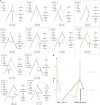Genomic exploration of the journey of Plasmodium vivax in Latin America
- PMID: 39804931
- PMCID: PMC11761655
- DOI: 10.1371/journal.ppat.1012811
Genomic exploration of the journey of Plasmodium vivax in Latin America
Abstract
Plasmodium vivax is the predominant malaria parasite in Latin America. Its colonization history in the region is rich and complex, and is still highly debated, especially about its origin(s). Our study employed cutting-edge population genomic techniques to analyze whole genome variation from 620 P. vivax isolates, including 107 newly sequenced samples from West Africa, Middle East, and Latin America. This sampling represents nearly all potential source populations worldwide currently available. Analyses of the genetic structure, diversity, ancestry, coalescent-based inferences, including demographic scenario testing using Approximate Bayesian Computation, have revealed a more complex evolutionary history than previously envisioned. Indeed, our analyses suggest that the current American P. vivax populations predominantly stemmed from a now-extinct European lineage, with the potential contribution also from unsampled populations, most likely of West African origin. We also found evidence that P. vivax arrived in Latin America in multiple waves, initially during early European contact and later through post-colonial human migration waves in the late 19th-century. This study provides a fresh perspective on P. vivax's intricate evolutionary journey and brings insights into the possible contribution of West African P. vivax populations to the colonization history of Latin America.
Copyright: © 2025 Lefebvre et al. This is an open access article distributed under the terms of the Creative Commons Attribution License, which permits unrestricted use, distribution, and reproduction in any medium, provided the original author and source are credited.
Conflict of interest statement
The authors have declared that no competing interests exist.
Figures





Similar articles
-
Origin of the New World Plasmodium vivax: Facts and New Approaches.Int Microbiol. 2019 Sep;22(3):337-342. doi: 10.1007/s10123-018-00053-1. Epub 2019 Jan 7. Int Microbiol. 2019. PMID: 30810995 Free PMC article.
-
Plasmodium vivax genomic surveillance in the Peruvian Amazon with Pv AmpliSeq assay.PLoS Negl Trop Dis. 2024 Jul 11;18(7):e0011879. doi: 10.1371/journal.pntd.0011879. eCollection 2024 Jul. PLoS Negl Trop Dis. 2024. PMID: 38991038 Free PMC article.
-
Nationwide genetic surveillance of Plasmodium vivax in Papua New Guinea reveals heterogeneous transmission dynamics and routes of migration amongst subdivided populations.Infect Genet Evol. 2018 Mar;58:83-95. doi: 10.1016/j.meegid.2017.11.028. Epub 2017 Dec 5. Infect Genet Evol. 2018. PMID: 29313805
-
Genomics, population genetics and evolutionary history of Plasmodium vivax.Adv Parasitol. 2013;81:203-22. doi: 10.1016/B978-0-12-407826-0.00005-9. Adv Parasitol. 2013. PMID: 23384624 Review.
-
Reduced polymorphism of Plasmodium vivax early transcribed membrane protein (PvETRAMP) 11.2.Parasit Vectors. 2023 Jul 17;16(1):238. doi: 10.1186/s13071-023-05851-9. Parasit Vectors. 2023. PMID: 37461081 Free PMC article. Review.
Cited by
-
On the use of generative models for evolutionary inference of malaria vectors from genomic data.bioRxiv [Preprint]. 2025 Jun 27:2025.06.26.661760. doi: 10.1101/2025.06.26.661760. bioRxiv. 2025. PMID: 40667127 Free PMC article. Preprint.
References
-
- World Health Organization. World malaria report 2022. 2022 Dec. https://www.who.int/publications/i/item/9789240064898
MeSH terms
LinkOut - more resources
Full Text Sources

